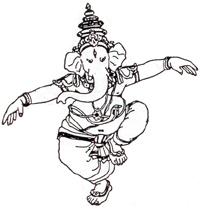|
 There are images of Ganesha with his left leg resting on a mouse and his
right leg lifted up. Mouse represents the Moochakam the Power house of
the breath of life. The left leg of Ganesha resting on the mouse should
be interpreted as exercising control over the flow of breath of life as
Ida Nadi which is responsible for the appearance of the phenomenal world.
The lifted right leg should be interpreted as an effort of the mind to
soar up through Pingala Nadi towards Sushumna, the brood house of the
serpent energy. In some images Ganesha's left leg is found resting on
a mouse and his right leg on a lion. Lion is the mount of Ganesha's immaculate
mother and a symbol of Pingala Nadi. The left leg on the mouse and the
right leg on the lion is the neutralisation of the Ida and Pingala, process
in the pranayam practice. In some images Ganesha's mount is seen carrying
a jewel in its mouth. This jewel is chintamani meaning mental illumination
or enlightenment, to be attained by the practice
of pranayam and other meditational methods. There are images of Ganesha with his left leg resting on a mouse and his
right leg lifted up. Mouse represents the Moochakam the Power house of
the breath of life. The left leg of Ganesha resting on the mouse should
be interpreted as exercising control over the flow of breath of life as
Ida Nadi which is responsible for the appearance of the phenomenal world.
The lifted right leg should be interpreted as an effort of the mind to
soar up through Pingala Nadi towards Sushumna, the brood house of the
serpent energy. In some images Ganesha's left leg is found resting on
a mouse and his right leg on a lion. Lion is the mount of Ganesha's immaculate
mother and a symbol of Pingala Nadi. The left leg on the mouse and the
right leg on the lion is the neutralisation of the Ida and Pingala, process
in the pranayam practice. In some images Ganesha's mount is seen carrying
a jewel in its mouth. This jewel is chintamani meaning mental illumination
or enlightenment, to be attained by the practice
of pranayam and other meditational methods.
Originally Ganesha had only two hands just like ordinary mortals. Later
on two more hands were added to distinguish him from ordinary mortals.
In course of time more hands were added, each hand carrying an object
different from the other. These several objects carried in the hands are
also symbol marks of certain metaphysical concepts as picked up by his
devotees from his all inclusive nature. The most popular form of Ganesha
is the four handed one. Two hands are lower and two are upper. The two
lower hands of which one is with palm pointing downwards is an offer to
his devotees of refuge and the other with palm pointing upwards is a promise
of protection and showering of grace on the refugee. Obviously, these
two hands presenting Abhaya and Varada mudras depict the influence of
the cult like Vaishnavacult upholding the doctrine of absolute surrender
and doctrine of grace. The two upper hands of which one holds an elephant
hook (Ankusa) is a symbol of selective faculty in choosing what is enabling
curbing the evil tendencies of the mind, and the other which holds a rope
(pasa) is a symbol of bond or worldly attachment. It is emblematic of
the enlightenment after the bonds of attachment are broken.
|